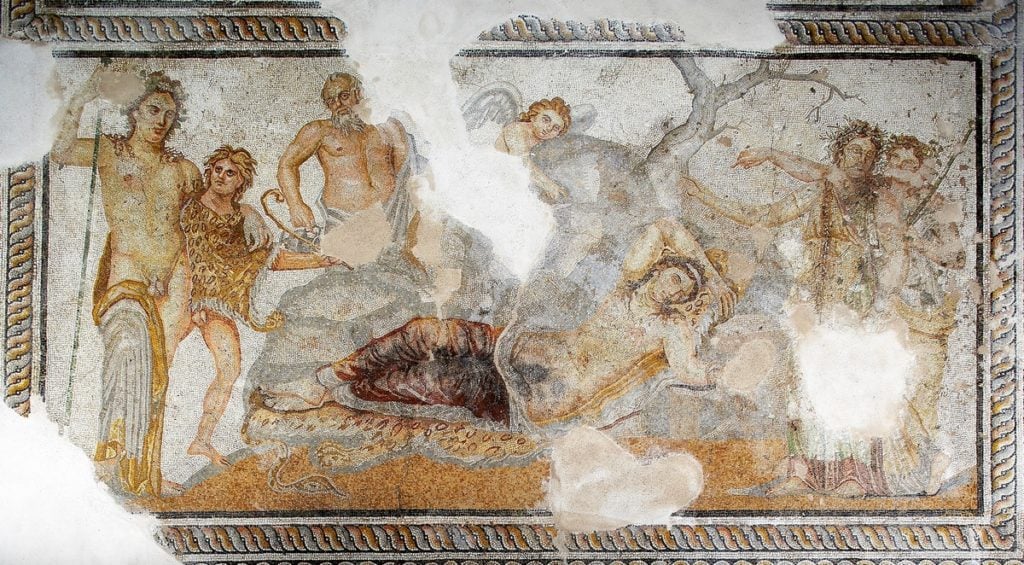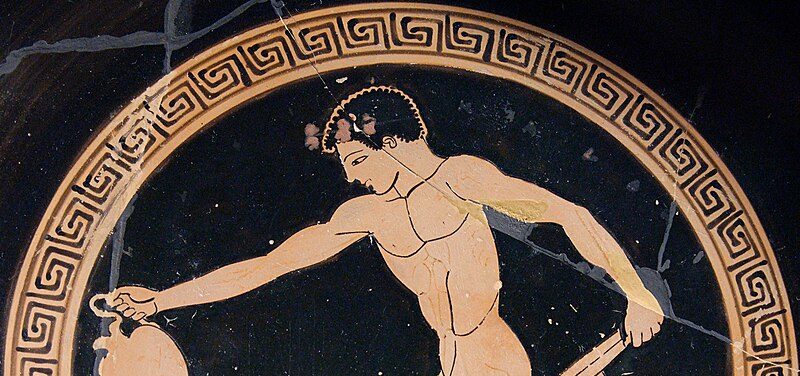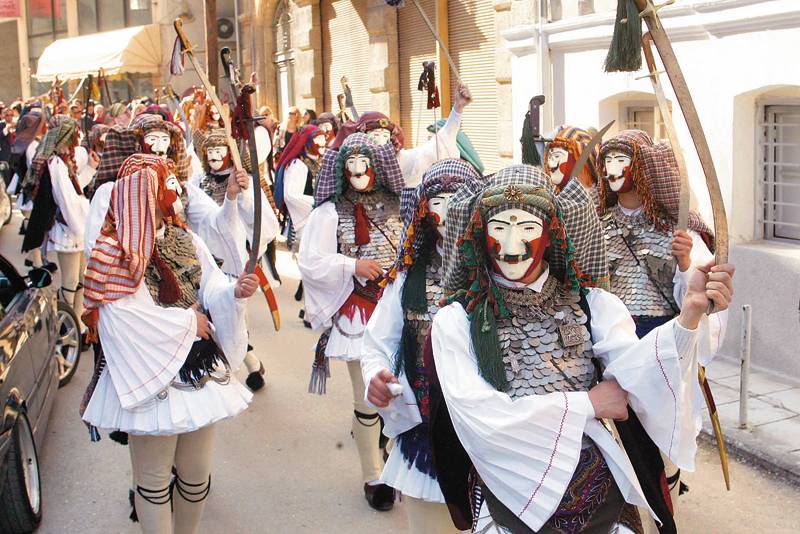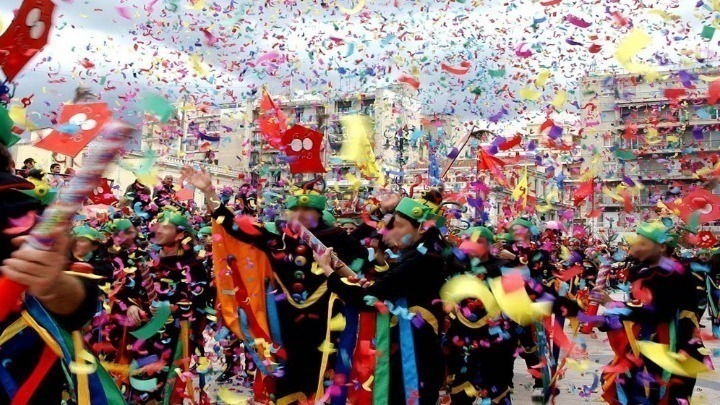
As the vibrant parades of Carnival sweep across Greece, one question comes to many people’s minds: Did the ancient Greeks celebrate Carnival?
From the samba-infused streets of Patras to the mask-adorned revelers in Rethymno, Naoussa, and Xanthi, one can’t help but wonder about the origins of this widespread celebration.
Carnival has been a festival historically linked to the Christian calendar leading up to Lent. It is known for its colorful and vibrant parades, the elaborate costumes of its participants, and a spirit of limitless joy that dazzles millions of people. However, the question about the roots of Carnival celebrations remain.
This question has captivated the minds of archaeologists and scholars throughout the centuries. Some historians and cultural enthusiasts speculate that the roots of Carnival stretch much further back than its link to the Christian calendar suggests.
It is more than evident to many that with ancient ceremonies to honor deities, particularly those from ancient Greece, having such an important role in the societies of antiquity, Carnival can’t be anything but a continuation of these ancient traditions.
So, did the ancient Greeks celebrate their own version of Carnival? And, if so, how, when, and more importantly, why? One can draw undeniable parallels between today’s festivities and the joyous rites dedicated to Dionysus; the popular god of wine, fertility, and ecstasy.
Did the Ancient Greeks Have a Carnival?
Dionysus occupied a central role in ancient Greek culture. He embodied the essence of being alive and feeling ecstatic and transformed. The festivals dedicated to his honor, especially the Dionysia, were not simply celebrations. They were profound expressions of human creativity with deep spirituality and important social aspects around them.
These celebrations paid homage to the God itself but also helped people feel—temporarily— free from the constraints of societal norms. This was a concept that deeply resonated with the love ancient Greeks had for freedom, something that is clearly an element of modern day carnival celebrations, too.

The Dionysia as Greece’s Festivals of Ecstasy
Among everything else, Dionysia stood out as quite an important part of ancient Greek religious and cultural life. This well-known festival was a loved celebration that included processions, dramatic contests, and the communal enjoyment of wine. These festivals showed no class divides either. Everyone was welcome to celebrate and honor the god.
The theatrical competitions were at the heart of Dionysia, too. There, people experimented with drama, creating a breeding ground for literary and dramatic innovation. One could certainly argue that these festivities gave rise to the seminal works of Aeschylus, Sophocles, Euripides, and Aristophanes. These were works that defined the world of Greek plays forever. It was very common for these plays to explore themes of identity, power, and the divine. They offered a reflective mirror to the Greeks, who could project their own lives into the characters of the plays.
The use of masks and costumes during the Dionysia was also an integral part of the Dionysian worship. By adopting new identities, participants were asked to forget their everyday selves and engage in a ritual that would blur the lines between that which was real and that which wasn’t. This was believed to allow them to connect deeply both with Dionysus himself and with each other.
Evidently, the tradition of masking finds a direct parallel in the emphasis on disguise and performance of the modern carnival celebrations. Today, masks are used both to conceal the identities of the participants and liberate them from any inhibitions. This creates a temporary but important change of social roles, something that makes carnival so popular nowadays.

The Ritual of Wine Drinking During Antiquity
Central to the Dionysian festivals was the abundant and ritualistic consumption of wine. This beloved drink was viewed not simply as a beverage but as a sacred way that led to ecstasy and enlightenment.
Dionysus, often depicted himself with a cup of wine in hand, symbolized the intoxicating power of the vines. This sacred drink for the Greeks dissolved the barriers between one’s self and society. It connected his drinkers to the core of life, reminding them of the reasons why they had to worship Dionysus. This ritual consumption of alcohol fostered a sense of unity and connection between the participants, too, similar to the Carnival’s own tradition of feasting and enjoying life, as well.
The liberal drinking of wine during the Dionysia also served as a reminder of the dual nature of Dionysus. He was both a bringer of joy and a creator of chaos. This duality reminded the Greeks of the delicate balance between the societal order and wildness of nature. One could certainly say that Carnival, too, showcases this balance: It provides for a period of excess joy and liberty that strengthens communal bonds and rejuvenates people overall.

The Dionysian Legacy in Modern Carnival
The Dionysian festivals with their rich combination of art, ecstasy, and communal celebration offer us a great tool—that of recognizing the origins of modern Carnival. The parallels between ancient Greek rites dedicated to Dionysus and contemporary Carnival festivities suggest a deep-rooted lineage and connection. Spanning from the use of masks and costumes in order to hide one’s true self, to the emphasis on liberation from societal norms and structures, Carnival and Dionysia share a lot in common. This is especially true of the timeless human need for celebration that goes beyond cultures and religions.
By examining the Dionysian festivities in ancient Greece, we can see the familiar and enduring human need for get-togethers that break the monotony of daily life. These organized fiestas allow people to express their joy, creativity, and delight.
The legacy of Dionysus, as seen in the ancient Dionysia and as is reflected in the vibrant celebrations of modern Carnival, continues to inspire millions of people across the world. It is a world in which the transformative power of joy remains a crucial element for a healthy and functioning society.

From Ancient Vineyards to Modern Streets
From the vineyards of ancient Greece to the samba-filled streets of contemporary Patras, the gap might seem vast. However, the core of these two events remains the same. It is evident that there is a link between these celebrations that goes beyond time, religion, and geography.
This is why the theory that Carnival finds its roots in Dionysian festivities is so compelling. It is supported by the mere fact that Carnival and Dionysia share a very similar pattern with a break from the daily routine of life, the blurring of social roles, and the communal joy found in music, dance, and, of course, alcohol.
Of course, scholars remain divided on how directly Carnival traditions can be traced back to the Dionysian festivals, as there is no clear archaeological evidence that connects the two. Some point to the Roman Bacchanalia (the Roman version of Dionysian festivals) as a more immediate predecessor. However, the link between Dionysus and carnival festivities is undeniable. They both celebrate the beauty of life and the temporary suspension of the ordinary.
In modern Greece, the spirit of Dionysian ecstasy lives on through Apokries, the Greek Carnival. Apokries customs such as the wearing of masks and seeking of indulgence before Lent resembles traditions of the ancient Dionysus celebrations. It is clear proof that shows a continuum of festive spirit—a joyful tradition that has evolved and yet remains deeply rooted in ancient Greek practices.
Conclusion: A Timeless Celebration
The question of whether the ancient Greeks celebrated Carnival in the way we understand it today may remain partially unanswered. However, the parallels between Dionysian festivals and modern Carnival festivities show clearly the universal appeal for communal celebration. It is in our human nature to want to celebrate and escape from our daily problems as a whole.
Hence, as we put our masks on and join the parade, we unknowingly participate in a tradition as old as Dionysus’ ecstatic rites themselves. This serves as enduring evidence that joy and festivity will always be integral parts of human culture.
See all the latest news from Greece and the world at Greekreporter.com. Contact our newsroom to report an update or send your story, photos and videos. Follow GR on Google News and subscribe here to our daily email!



